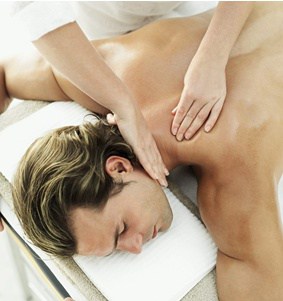
Why Able Body for Massage Therapy in Lethbridge?
The massage therapists at Able Body are experts in multiple techniques, such as standard Swedish massage, prenatal massage, and deep tissue techniques. They also have experience with many conditions, such as back pain, neck pain, headaches, and sports injuries. The massage therapists at Able Body understand the importance of working together with other healthcare providers. They will work with the rest of your healthcare team to ensure you are getting the best care for your specific needs. We offer experienced therapists, direct billing of insurance and a convenient location in central Lethbridge, making Able Body Health Clinic the best place to come for massage therapy in Lethbridge!
Massage Therapists at Able Body
What is massage therapy?
Massage is the use of hands or specific tools to manipulate muscles and other connective tissues. During a treatment, the therapist will use pressure, rubbing, or kneading to manipulate the relevant soft tissues. The goal is reducing pain, improving function, aiding the healing process, and promoting relaxation. Massage has been practiced in most cultures throughout human history. It was one of the earliest tools that people used to try to relieve pain. In fact, one of the most natural and instinctive things to do when we hurt ourselves is to rub the area that hurts!
Why get a massage?
There are many health benefits that can come from massage therapy. It is commonly used by athletes for warm-up and recovery, or by workers for pain and stiffness relief. However, massage is also great for healthy individuals, to improve well-being. Whether someone needs a moment of relaxation, reduced muscle tension or relief from chronic pain, massage can enhance one's overall sense of physical health and quality of life. Massage therapy is often used to treat:
Low back pain
Massage therapy has been shown to be helpful for sub acute and chronic nonspecific low back pain. The effect is greater if combined with exercise! In fact, the Consumer Reports Overview of Alternative Therapies (2011) placed Swedish massage and deep tissue techniques among the most effective therapies for back pain, as rated by the public.
Neck pain and whiplash
Swedish or clinical massage has been shown to add benefit to self-care for neck pain. The Consumer Reports Overview of Alternative Therapies (2011) found Swedish massage and deep tissue techniques to be among the top 3 most effective therapies for neck pain.
Sciatica
Massage therapy may help to increase range of motion and decrease pain caused by sciatica.
Headaches
Clinical massage is recommended as an effective treatment for chronic tension-type headaches. It is even more effective when combined with exercise. According to the Consumer Reports Overview of Alternative Therapies (2011), 40% of the public reported that deep tissue techniques helped a lot with their headaches.
Pregnancy-related pain
Massage to the lower back has been shown to decrease pain, shorten delivery time and increase satisfaction with birth experience.
Stress
Massage therapy has been shown to be an effective method in reducing occupational stress.
Regular massage could also be an important part of one's health maintenance plan. It can improve quality of life by:
- Reducing muscle tension
- Improving circulation
- Stimulation of the lymphatic system
- Reduction of stress hormones
- Increasing joint mobility and flexibility
- Speeding recovery of soft tissue injuries
What are some of the different techniques?
Swedish
Sometimes called ‘classical’. This is the most common form of massage therapy provided in Western countries; it is the core of most training programs. This technique involves a gentle, full-body approach that can help release muscle knots, decrease pain, and promote relaxation. The technique relies on a combination of kneading, long, flowing strokes, deep circular motions and passive joint movement techniques using a variety of pressures.
Deep tissue, or 'sport' massage
Deep tissue massage uses more pressure than a standard Swedish technique. It’s a good option for those with chronic muscle soreness or tightness. The technique uses slow strokes and deep finger pressure to relieve tension from the deepest layers of your muscles.
Prenatal massage
Prenatal massage might involve elements of Swedish/classical techniques, deep tissue techniques, trigger point therapy, etc. These techniques are modified and adapted to the specific needs of an expectant mother. It can be a safe way for women to get relief from muscle pain and tension during pregnancy. Patients will often lie on their side or on a specially designed pillow or table with a cutout for the belly. There are also many alternate positions to facilitate patient comfort.
Clinical massage
Clinical massage might involve elements of classical techniques, deep tissue techniques, stretching, etc. The intention is to accomplish specific goals, such as releasing a muscle spasm.
Thai Foot Massage
Thai foot massage involves treatment of the feet, knees and lower legs. The therapist will use their hands, thumbs, knuckles and a rounded wooden Thai foot massage stick to stimulates certain areas of the feet and relieve muscle tension.
Myofascial cupping
Myofascial cupping involves the application of decompressed cups on the skin. These create a vacuum effect that lifts underlying tissues such as the fascia and muscles, blood and other fluid that is close to the surface of the skin. Sometimes the suctioned cups are moved across the affected area. This can be a somewhat aggressive technique that can sometimes leave bruising after the treatment.
Professional massage therapist regulation
While many individuals might provide “massage”, a Registered Massage Therapist (RMT) is often preferred. RMTs are well trained and their services are covered by private insurance plans. RMTs have completed a diploma program at a recognized school, which allows them to become a member of one of Canada’s RMT associations.
There are four professional associations that contribute to the professional development of massage therapy in Alberta. Those are the MTAA, the NHPC, the CMMOTA and the CRMTA. You can verify that your massage therapy in Lethbridge is licensed by using the search tools available at each associations webpage. These professional associations are actively working to have the profession regulated in Alberta. This would enable them to regulate the conduct of RMTs through standards of practice and codes of ethics. Regulation would be in the interest of the public by reducing risk of harm. It would provide a public record of practitioners who violate the College's Code of Ethics and maintain a public registry of all RMTs in the provincial College. Finally, it would help to protect professional titles such as "Registered Therapist" (RMT).
For more information about any of the topics discussed above, please feel free to contact our clinic and speak to one of our health professionals. With experienced therapists, direct insurance billing and a central location, Able Body is the best place to come for massage therapy in Lethbridge.





